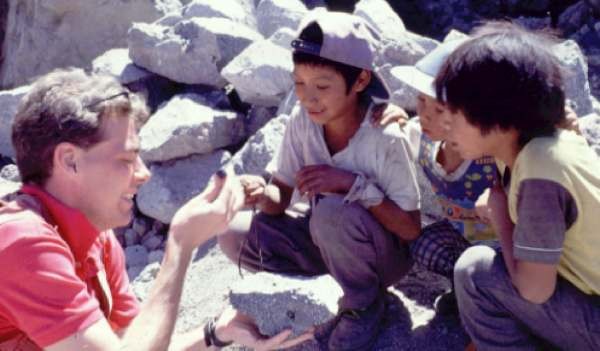Barry I. Cameron

1999 Photo
Currently: Associate Professor, Geosciences, University of Wisconsin
B. Sc. Honours Thesis
The Contact Metamorphic Effects of a Granitoid Pluton on Zinc-Lead Mineralization in the Manganiferous Metasediments of the Meguma Group, Eastville, Colchester County, Nova Scotia
(PDF - 6.5 Mb)
The distribution of mineral resources in the Meguma Zone has been found to be spatially associated with the transition of the Goldenville and Halifax Formations (GHT, Zentilli and MacInnis, 1984). The Eastville deposit constitutes the only significant zinc and lead mineralization in the Cambro-Ordovician Meguma rocks. The study area is located between Eastville and Hattie Lake, Colchester County, and consists of a 10 km section of steeply dipping GHT, striking to the northeast. The deposit is intruded by a Devonian-Carboniferous granitoid pluton making this locality a unique place to study the interaction of granitoids with mineralized GHT.
The boundary between the Goldenville and Halifax Formations can be mapped by the presence of a locally calcareous and contorted manganiferous bed consisting of intercalations of quartz metawacke and slate. The Meguma Group of the Eastville area has undergone regional metamorphism to lower greenschist facies reflected in the observed assemblage of chlorite + spessartine garnet + muscovite + quartz, indicating temperatures of between 370 and 420oC. Heat from the intrusion of the granitoid pluton thermally metamorphosed the country rock to a staurolite-almandine garnet-biotite schist. Garnet-biotite geothermometry has been used to estimate the temperature of this episode at around 580oC, which agrees well with mineral assemblage estimates. The contact aureole is distinct by the absence of carbonate. The granitoid pluton at Eastville is a peraluminous granodiorite-monzograntie complex that can be interpreted as being produced by magmatic differentiation. The biotite granodiorite contains reversely zoned garnets as an accessory mineral.
Sphalerite in the cores of some regional metamorphic spessartine garnet indicates the Zn mineralization is of pre-regional metamorphic age. This textural evidence poses constraints on possible genetic hypotheses. The relatively old age of the mineralization and the complex history of the Meguma Zone has increased the probability of post-depositional redistribution of the base metals.
Keywords:
Pages: 113
Supervisor: Marcos Zentilli



